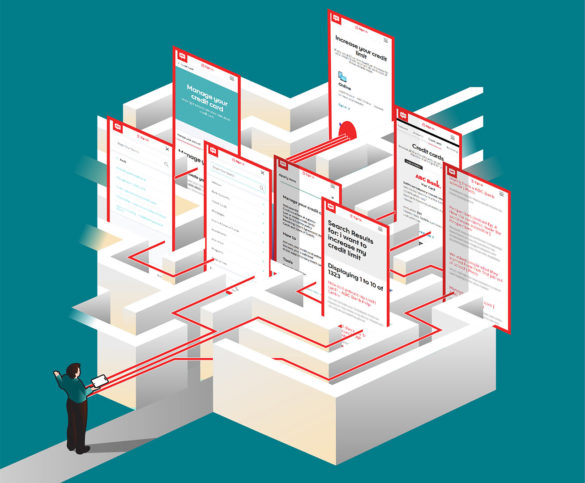Virtual banking assistants arrived several years ago at a handful of mostly large institutions. Now they are increasingly being implemented by both large and small banks and credit unions.
The reason for the wider adoption is because virtual assistants, powered by artificial intelligence, solve a wide range of problems, from providing 24/7 service options to shortening wait times for customers to get help. All these solutions serve the common goal of improving the digital customer experience.
Intelligent, guided self-service is one of the best ways to improve customer satisfaction for an institution’s digital channels. Here’s a quick rundown of the five biggest reasons any bank or credit union should consider implementing a virtual banking assistant.
1. Your Customers Are Going Digital, So Why Aren’t You?
While digital adoption had already been drastically increasing among consumers, the start of the pandemic signaled a rapid adoption of digital channels across all demographics. Even in the long run, however, it doesn’t look like most users are leaving the digital world any time soon. According to Insider Intelligence, U.S. digital banking users are projected to grow past 200 million in 2022. Over 75% of the U.S. population is currently banking digitally, so prioritizing the digital experience is becoming even more important for maintaining a positive customer experience.
Furthermore, virtual banking assistance is an increasingly requested online banking feature among digital banking users, especially the younger demographics. According to a Finn AI white paper, 31% of Gen Z and 28% of Millennials surveyed said they wanted to use virtual assistance for managing money as a future offering from their bank or credit union. User preferences are evolving, and it’s up to financial institutions to keep up with the ever-shifting needs of their increasingly digital-first customers (or potentially lose them to a competitor who can).
The Young and The Digital:
Nearly a third of both Gen Z and Millennials want virtual assistance from their financial institution.
2. Your Call Centers Are Swamped and Users Are Fed Up
Call centers are seeing an increase in call volumes as users move to primarily banking from home. At the same time, staffing is becoming a major concern of these call centers as well. A July 2021 report from Five9 found 44% of call centers reporting staffing issues and 55% experiencing higher than normal call volumes. These two issues together create an environment where there are less support staff to handle more questions, increasing wait times and overall frustration for customers and members who need support.
A virtual banking assistant can be the key to solve this issue: Up to 80% of queries that call centers receive can potentially be handled by an AI-powered chatbot without requiring human intervention. This frees up agent time to focus on high-value conversations, ensuring that live human support staff can provide help where it’s needed most.
An AI-powered chatbot is also an always-on solution, meaning it’s ready to help your customers 24/7. No longer will they only be able to contact you during your set business hours.
3. Your Digital Experience Isn’t As Intuitive As You Think
As banking moves even further digitally, financial institutions will find themselves needing to put an increasing amount of information on their website. The more information that is delivered onto a bank or credit union’s app and website, the harder it can be for consumers to find what they’re looking for.
Enabling people to get the info they need easily and quickly is a challenge. One way to make sure that users have full, instant access to any information they need is by connecting them with a virtual banking assistant that can quickly redirect them to any information on your website or app, just by asking.
Rather than trying to fully redesign layouts and user interfaces to try and put all your information within easy reach, an AI-powered chatbot can fetch a user any information they want without them ever having to leave the messaging window. It helps ensure that you don’t put customers or members through the frustrating experience of hunting down forms, files and fields on your website.
Pathfinder:
The frustration of navigating the typical banking web menu maze can be avoided with the help of a virtual assistant.
4. Your Competitors Are Digital Natives
Fintechs, neobanks and digital banks are on the rise, and they’re poised to take a big share of the market. These competitors were born and raised in the digital world, so their knowledge of the digital experience is often unmatched. Almost half of banking customers under 55 say they’d switch their banking provider for better digital features, according to Mobiquity.
Your digital banking experience has to stay competitive in order to retain the loyalty of younger demographics. A virtual banking assistant is a feature you can offer customers to keep your digital experience up-to-date. Consumers say they’ll remain loyal to the financial institutions that give them the best experience.
By implementing AI-powered chat, you’re also laying the groundwork for future innovation. As the capabilities of virtual assistants grow, so does the technological gap between those institutions that have them and those that don’t.
5. Implementation Has Become Easier
Installing a virtual banking assistant onto your digital channels has become simpler. Software-as-a-service vendors that employ a no-code installation process can get an AI-powered chatbot up and running in four weeks or less. The Finn AI chatbot in particular comes pre-trained on over 800 banking workflows, covering numerous customer requests and inquiries. The more the chatbot gets used, the smarter it becomes.
In addition, Finn AI is pre-integrated into digital banking and customer support platforms including Q2 and Glia, and can be launched on these platforms rapidly without any development effort.








